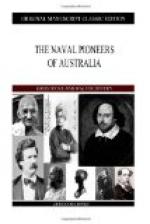In July, Lieutenant-Colonel Foveaux arrived from England, and was surprised to find the existing state of affairs. By virtue of seniority, he succeeded Johnston as lieutenant-governor, and appointed another man in place of MacArthur, but did not interfere in any other way, contenting himself with sending to England a full report of the affair. Foveaux was in turn succeeded by Colonel Paterson, who arrived at the beginning of 1809, and who also declined to interfere in the business, but he granted Johnston leave of absence to proceed to England, MacArthur and two other officers accompanying him.
Meanwhile some of the free settlers had begun to show indications of a desire to help Bligh, who, to prevent accidents, was taken by the rebels from his house and lodged with his daughter a close prisoner in the barracks. Later on, he signed an agreement with Paterson to leave the colony for England in a sloop of war then bound home.
Bligh and his daughter embarked on the vessel, but on the way she put into the Derwent river, in Van Diemen’s Land, where the [Sidenote: 1809] deposed governor landed, and at first thought he would be able to re-establish his authority, but the spirit of rebellion had taken hold; he was compelled to re-embark soon after, but he remained in Tasmanian waters on board ship until Governor Macquarie arrived from England.
For the English Government, in due course, had heard of the state of affairs, and woke up to the necessity for strong action. In December, 1809, there arrived in Sydney Harbour a 50-gun frigate and a transport, bringing Governor Macquarie, with his regiment of Highlanders, the 73rd. His orders were to restore Bligh for twenty-four hours and send home the New South Wales Corps, with every officer who had been concerned in the rebellion under arrest, and the regiment, as we said in a former chapter, was disbanded; Macquarie was himself then to take over the government.
The absence of Bligh from the colony prevented his restoration being literally carried out, but Macquarie issued proclamations which served the purpose, and restored all the officials who had been put out by the rebels. Macquarie soon made himself popular with the colonists, and the best proof of his success is the fact that he governed the colony for twelve years, and his administration, though an important epoch in its history, cannot be gone into here as he was not a naval man.
Bligh, the last of the naval governors, arrived in England in October, was made a rear-admiral, and died in 1817. Johnston was tried by court-martial and cashiered, and returned to the colony, becoming one of its best settlers and the founder of one of Sydney’s most important suburbs. MacArthur was ordered not to return to the colony for eight years. He returned in 1817, bringing with him sons as vigorous as himself. Ultimately he became a member of the Legislative Council, and his services and those of his descendants will justly be remembered in Australia long after the petty annoyances to which he was subjected and the improper manner in which he resisted them have been totally and happily forgotten.




